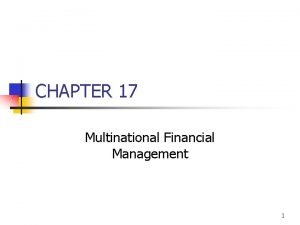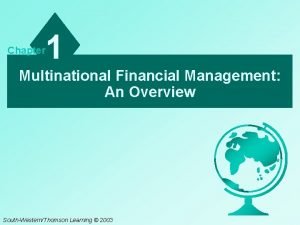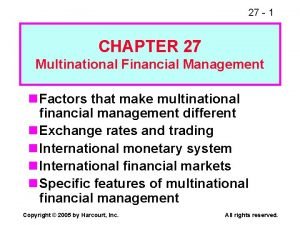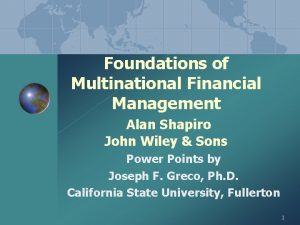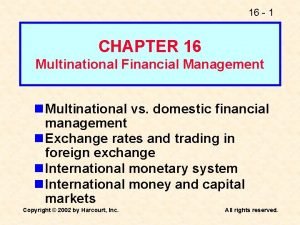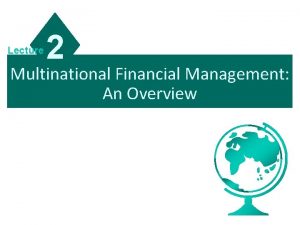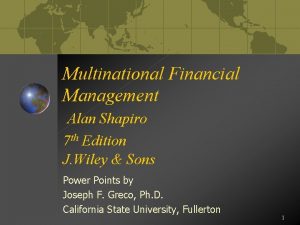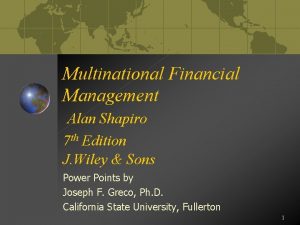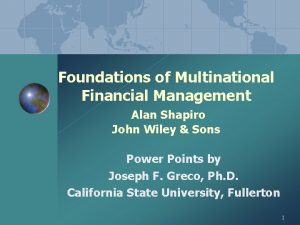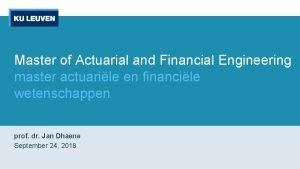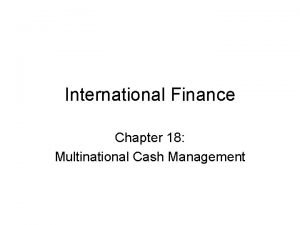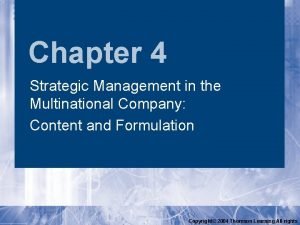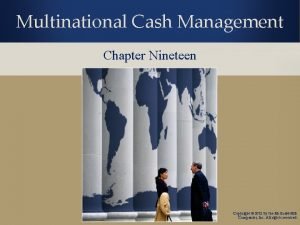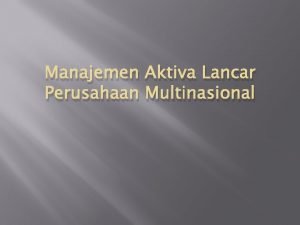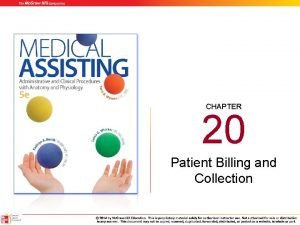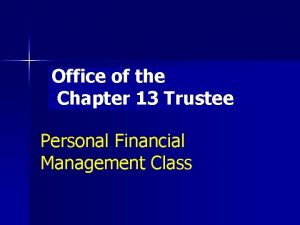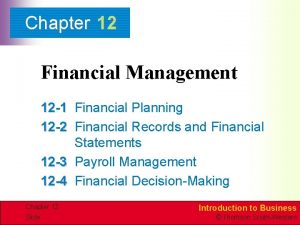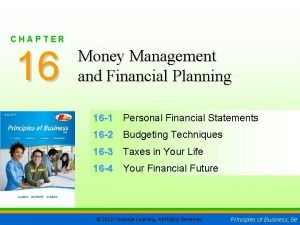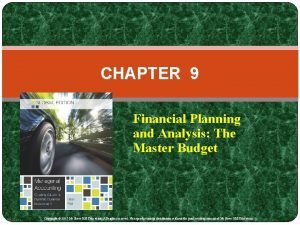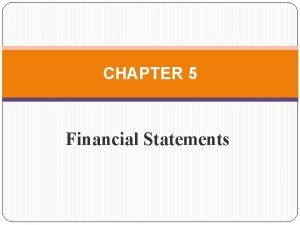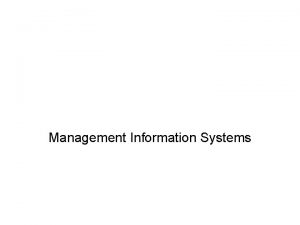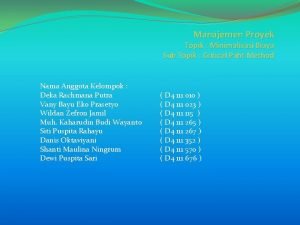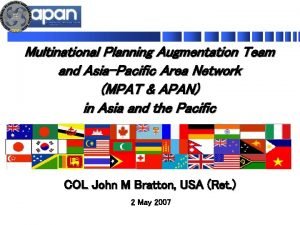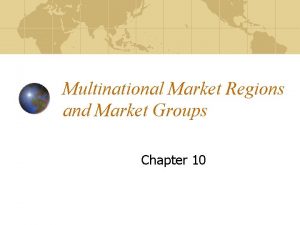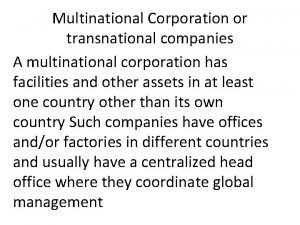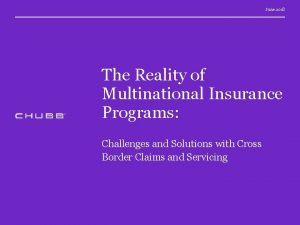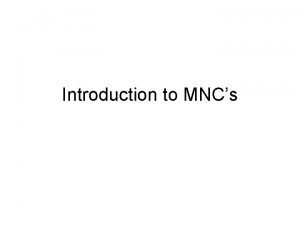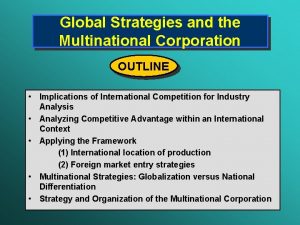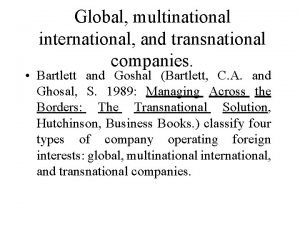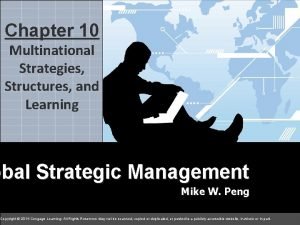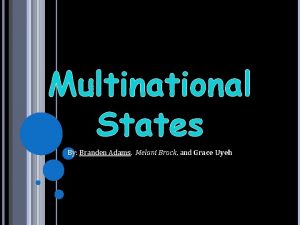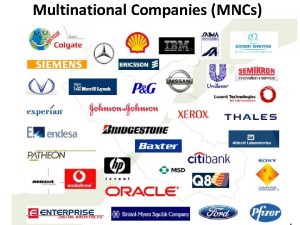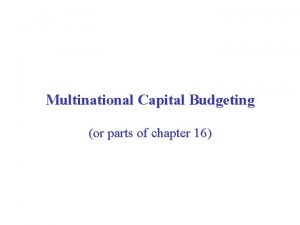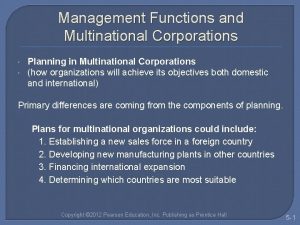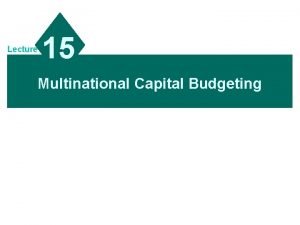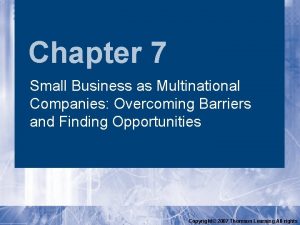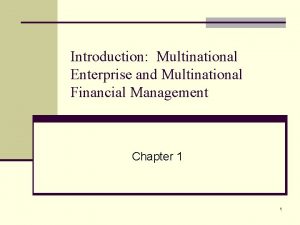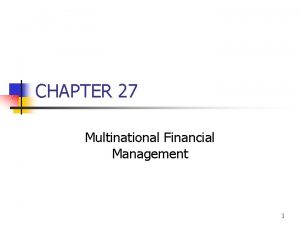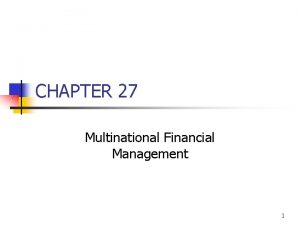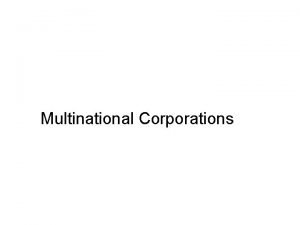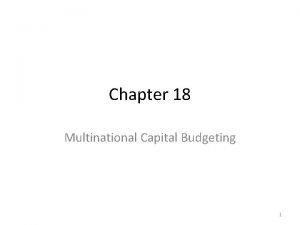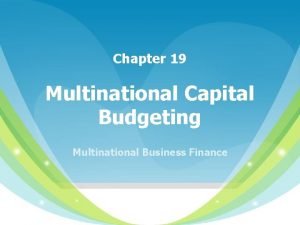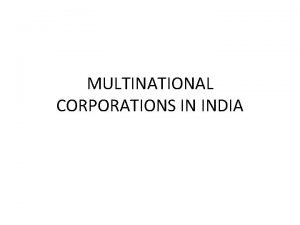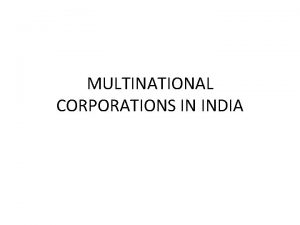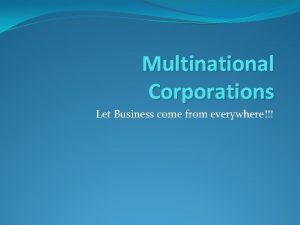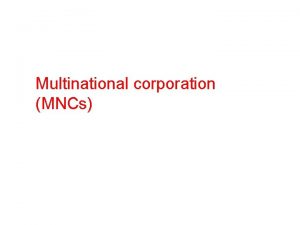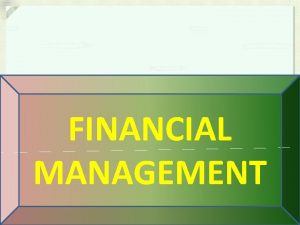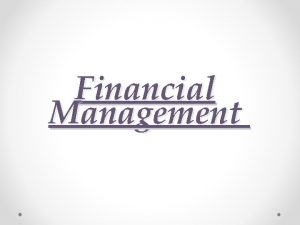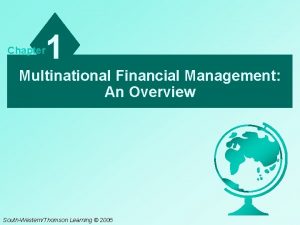CHAPTER 17 Multinational Financial Management 1 Topics in
























































- Slides: 56

CHAPTER 17 Multinational Financial Management 1

Topics in Chapter n n n Factors that make multinational financial management different Exchange rates and trading International monetary system International financial markets Specific features of multinational financial management 2

Intrinsic Value in a Global Context Regulatory systems Currency exchange rates Culture Free cash flow (FCF) FCF 1 FCF 2 FCF∞ Value = + + ···+ 1 2 (1 + WACC)∞ (1 + WACC) Weighted average cost of capital (WACC) Global financial markets Cost of debt Cost of equity Political risk 3

What is a multinational corporation? n n n A multinational corporation is one that operates in two or more countries. At one time, most multinationals produced and sold in just a few countries. Today, many multinationals have worldwide production and sales. 4

Why do firms expand into other countries? n n n To seek new markets. To seek new supplies of raw materials. To gain new technologies. To gain production efficiencies. To avoid political and regulatory obstacles. To reduce risk by diversification. 5

Major Factors Distinguishing Multinational from Domestic Financial Management n n n Currency differences Economic and legal differences Language differences Cultural differences Government roles Political risk 6

Consider the following exchange rates: Euro Swedish Krona n n U. S. $ to buy 1 Unit 1. 2500 0. 1481 Are these currency prices direct or indirect quotations? Since they are prices of foreign currencies expressed in U. S. dollars, they are direct quotations (dollars per currency). 7

What is an indirect quotation? n n n An indirect quotation gives the amount of a foreign currency required to buy one U. S. dollar (currency per dollar). Note than an indirect quotation is the reciprocal of a direct quotation. Euros and British pounds are normally quoted as direct quotations. All other currencies are quoted as indirect. 8

Calculate the indirect quotations for euros and kronor. n n Euro: Krona: 1 / 1. 2500 = 1 / 0. 1481 = 0. 8000 6. 7522 Indirect Quotes: # of Units of Direct Quote: U. S. $ per foreign Foreign Currency currency per U. S. $ Euro Swedish krona 1. 2500 0. 1481 0. 8000 6. 7522 9

What is a cross rate? n n A cross rate is the exchange rate between any two currencies not involving U. S. dollars. In practice, cross rates are usually calculated from direct or indirect rates. That is, on the basis of U. S. dollar exchange rates. 10

Calculate the two cross rates between euros and kronor. Cross Rate = Kronor Dollar × Dollars Euros = 6. 7522 x 1. 2500 = 8. 3334 Kronor/Euro 11

Euros/Krona Cross Rate n n Euros/Krona cross rate is reciprocal of the Kronor/Euro cross rate: Euros/Krona cross rate = 1/(8. 3334) = 0. 1185 12

Example of International Transactions n Assume a firm can produce a liter of orange juice in the U. S. and ship it to Spain for $1. 75. If the firm wants a 50% markup on the product, what should the juice sell for in Spain? Target price = ($1. 75)(1. 50)=$2. 625 Spanish price = ($2. 625)(0. 8000 euros/$) = € 2. 10. (More. . . ) 13

Example (Continued) Now the firm begins producing the orange juice in Spain. The product costs 2. 0 euros to produce and ship to Sweden, where it can be sold for 20 kronor. What is the dollar profit on the sale? 2. 0 euros (8. 4403 kronor/euro) = 16. 88 kronor. 20 – 16. 88 = 3. 12 kronor profit. Dollar profit = 3. 12 kronor(0. 1481 $ per krona) = $0. 46. n 14

What is exchange rate risk? n Exchange rate risk is the risk that the value of a cash flow in one currency translated from another currency will decline due to a change in exchange rates. 15

Currency Appreciation and Depreciation n Suppose the exchange rate goes from 6. 7522 kronor per dollar to 8 kronor per dollar. A dollar now buys more kronor, so the dollar is appreciating, or strengthening. The krona is depreciating, or weakening. 16

Affect of Dollar Appreciation n Suppose the profit in kronor remains unchanged at 3. 12 kronor, but the dollar appreciates, so the exchange rate is now 10 kronor/dollar. Dollar profit = 3. 12 kronor / (10 kronor per dollar) = $0. 312. Strengthening dollar hurts profits from international sales. 17

The International Monetary System from 1946 -1971 n n n Prior to 1971, a fixed exchange rate system was in effect. The U. S. dollar was tied to gold. Other currencies were tied to the dollar at fixed exchange rates. 18

Former System (Continued) n n n Central banks intervened by purchasing and selling currency to even out demand so that the fixed exchange rates were maintained. Occasionally the official exchange rate for a country would be changed. Economic difficulties from maintaining fixed exchange rates led to its end. 19

The Current International Monetary System n n The current system for most industrialized nations is a floating rate system where exchange rates fluctuate due to changes in demand. Currency demand is due primarily to: n n Trade deficit or surplus Capital movements to capture higher interest rates 20

The European Monetary Union n In 2002, the full implementation of the “euro” was completed (those still holding former currencies have 10 years to exchange them at a bank). The European Central Bank now controls the monetary policy of the EMU countries using the euro. 21

The European Monetary Union Members that Use the Euro Austria France Italy Portugal Belgium Germany Luxembourg Slovenia Cyprus Greece Malta Spain Finland Ireland Netherlands Slovakia* *Joined in 2009. 22

Pegged Exchange Rates n n Many countries still used a fixed exchange rate that is “pegged, ” or fixed, with respect to another currency. Examples of pegged currencies: n n Chinese yuan, about 6. 82 yuan/dollar (Spring 2009) Chad uses CFA franc, pegged to French franc which is pegged to euro. 23

What is a convertible currency? n n n A currency is convertible when the issuing country promises to redeem the currency at current market rates. Convertible currencies are freely traded in world currency markets. Residents and nonresidents are allowed to freely convert the currency into other currencies at market rates. 24

Problems Due to Nonconvertible Currency n n It becomes very difficult for multinational companies to conduct business because there is no easy way to take profits out of the country. Often, firms will barter for goods to export to their home countries. 25

Examples of nonconvertible currencies n n Chinese yuan Venezuelan bolivar Uzbekistan sum Vietnamese dong 26

What is the difference between spot rates and forward rates? n n n A spot rate is the rate applied to buy currency for immediate delivery. A forward rate is the rate applied to buy currency at some agreed-upon future date. Forward rates are normally reported as indirect quotations. 27

When is the forward rate at a premium to the spot rate? n n n If the U. S. dollar buys fewer units of a foreign currency in the forward than in the spot market, the foreign currency is selling at a premium. For example, suppose the spot rate is 0. 5 £/$ and the forward rate is 0. 4 £/$. The dollar is expected to depreciate, because it will buy fewer pounds. (More. . . ) 28

Spot rate = 0. 5 £/$ Forward rate = 0. 4 £/$. n n The pound is expected to appreciate, since it will buy more dollars in the future. So the forward rate for the pound is at a premium. 29

When is the forward rate at a discount to the spot rate? n n If the U. S. dollar buys more units of a foreign currency in the forward than in the spot market, the foreign currency is selling at a discount. The primary determinant of the spot/forward rate relationship is the relationship between domestic and foreign interest rates. 30

What is interest rate parity? Interest rate parity implies that investors should expect to earn the same return on similar-risk securities in all countries: Forward rate = 1 + rh 1 + rf Spot rate Forward and spot rates are direct quotations. rh = periodic interest rate in the home country. rf = periodic interest rate in the foreign country. 31

Interest Rate Parity Example Assume 1 euro = $1. 27 in the 180 -day forward market and 180 day risk-free rate is 6% in the U. S. and 4% in Spain. Does interest rate parity hold? Spot rate = $1. 25. rh = 6%/2 = 3%. rf = 4%/2 = 2%. n (More. . . ) 32

Interest Rate Parity (Continued) 1 + rh Forward rate = Spot rate 1 + rf Forward rate 1. 03 = 1. 02 1. 25 Forward rate = 1. 2623. If interest rate parity holds, the implied forward rate, 1. 2623, would equal the observed forward rate, 1. 2700; so parity doesn’t hold. 33

Which 180 -day security (U. S. or Spanish) offers the higher return? n n A U. S. investor could directly invest in the U. S. security and earn an annualized rate of 6%. Alternatively, the U. S. investor could convert dollars to euros, invest in the Spanish security, and then convert profit back into dollars. If the return on this strategy is higher than 6%, then the Spanish security has the higher rate. 34

What is the return to a U. S. investor in the Spanish security? n n Buy $1, 000 worth of euros in the spot market: $1, 000(0. 80 euros/$) = 800 euros. Spanish investment return (in euros): 800(1. 02)= 816 euros. (More. . . ) 35

U. S. Return (Continued) n n n Buy contract today to exchange 816 euros in 180 days at forward rate of 1. 2700 dollars/euro. At end of 180 days, convert euro investment to dollars: € 816 (1. 2700 $/€) = $1, 036. 32. Calculate the rate of return: $36. 32/$1, 000 = 3. 632% per 180 days = 7. 26% per year. (More. . . ) 36

The Spanish security has highest return, even with lower interest rate. n n U. S. rate is 6%, so Spanish securities at 7. 26% offer a higher rate of return to U. S. investors. But could such a situation exist for very long? 37

Arbitrage n n Traders could borrow at the U. S. rate, convert to euros at the spot rate, and simultaneously lock in the forward rate and invest in Spanish securities. This would produce arbitrage: a positive cash flow, with no risk and none of the traders own money invested. 38

Impact of Arbitrage Activities n n Traders would recognize the arbitrage opportunity and make huge investments. Their actions would tend to move interest rates, forward rates, and spot rates to parity. 39

What is purchasing power parity? n Purchasing power parity implies that the level of exchange rates adjusts so that identical goods cost the same amount in different countries. Ph = Pf(Spot rate), or Spot rate = Ph/Pf. 40

U. S. grapefruit juice is $2. 00/liter. If purchasing power parity holds, what is price in Spain? n n Spot rate = Ph/Pf. $1. 2500= $2. 00/Pf Pf = $2. 00/$1. 2500 = 1. 6 euros. Do interest rate and purchasing power parity hold exactly at any point in time? 41

Impact of relative Inflation on Interest Rates and Exchange Rates n n Lower inflation leads to lower interest rates, so borrowing in low-interest countries may appear attractive to multinational firms. However, currencies in low-inflation countries tend to appreciate against those in highinflation rate countries, so the true interest cost increases over the life of the loan. 42

Describe the international money and capital markets. n Eurodollar markets n n n Dollars held outside the U. S. Mostly Europe, but also elsewhere International bonds n n Foreign bonds: Sold by foreign borrower, but denominated in the currency of the country of issue. Eurobonds: Sold in country other than the one in whose currency it is denominated. 43

To what extent do capital structures vary across different countries? n n Early studies suggested that average capital structures varied widely among the large industrial countries. However, a recent study, which controlled for differences in accounting practices, suggests that capital structures are more similar across different countries than previously thought. 44

Multinational Capital Budgeting Decisions n n n Foreign operations are taxed locally, and then funds repatriated may be subject to U. S. taxes. Foreign projects are subject to political risk. Funds repatriated must be converted to U. S. dollars, so exchange rate risk must be taken into account. 45

Foreign Project Analysis n n n Project future expected cash flows, denominated in foreign currency Use the interest rate parity relationship to convert the future expected foreign cash flows into dollars. Discount the dollar denominated cash flows at the risk-adjusted cost of capital for similar U. S. projects. 46

Capital Budgeting Example n n U. S. company invests in project in Japan. Expected future cash flows: n n CF 0 = - ¥ 1, 000 million. CF 1 = ¥ 500 million. CF 2 = ¥ 800 million. Risk-adjusted cost of capital for a imilar U. S. project = 10%. 47

Interest Rate and Exchange Rate Data n n Current spot exchange rate = 110 ¥/$. U. S. government bond rates: n n n 1 -year bond = 2. 0% 2 -year bond = 2. 8% Japan government bond rates: n n 1 -year bond = 0. 05% 2 -year bond = 0. 26% 48

Multi-year Interest Rate Parity Relationship Expected future 1 + rh exchange rate = Spot rate 1 + rf t Echanged rates are direct quotations. rh = annual interest rate in the home country. rf = annual interest rate in the foreign country. 49

Expected Future Exchange Rates (Continued) n n Direct spot rate = (1/110 ¥/$) = 0. 009091 $/¥. Expected exchange rate in 1 year: = (Spot rate)[(1+rh)/(1+rf)]1 = (0. 009091)(1+0. 02)/(1+0. 0005) = 0. 009268 50

Expected Future Exchange Rates (Continued) n Expected exchange rate in 2 years: = (spot rate)[(1+rh)/(1+rf)]2 = (0. 009091)[(1+0. 028)/(1+0. 0026)]2 = 0. 009557 51

Project Cash Flows 0 Cash flows in yen Expected exchange rates Cash flows in dollars 1 2 -¥ 1, 000 ¥ 500 ¥ 800 0. 009091 0. 009268 0. 009557 -$9. 09 $4. 63 $7. 65 52

Project NPV = -$9. 09 $7. 65 $4. 63 + + (1 + 0. 10)2 NPV = $1. 44 million. 53

International Cash Management n n n Distances are greater. Access to more markets for loans and for temporary investments. Cash is often denominated in different currencies. 54

Multinational Credit Management n n n Credit is more important, because commerce to lesser-developed countries often relies on credit. Credit for future payment may be subject to exchange rate risk. Many companies buy export credit risk insurance when granting credit to foreign customers. 55

Multinational Inventory Management n n Inventory decisions can be more complex, especially when inventory can be stored in locations in different countries. Some factors to consider are shipping times, carrying costs, taxes, import duties, and exchange rates. 56
 Interest rate parity example
Interest rate parity example Centralized multinational financial management
Centralized multinational financial management Multinational financial management requires that
Multinational financial management requires that Foundations of multinational financial management
Foundations of multinational financial management Multinational vs domestic financial management
Multinational vs domestic financial management Multinational financial management definition
Multinational financial management definition Multinational financial management requires that
Multinational financial management requires that Multinational financial management definition
Multinational financial management definition Multinational financial management shapiro
Multinational financial management shapiro How to control multinational corporations
How to control multinational corporations Multinational financial system
Multinational financial system Febadvisor
Febadvisor Netting finance
Netting finance Strategic management in multinational companies
Strategic management in multinational companies Multinational management is
Multinational management is Multinational cash management
Multinational cash management Manajemen aktiva lancar
Manajemen aktiva lancar Financial management chapter 8 risk and return
Financial management chapter 8 risk and return Chapter 20 patient collections and financial management
Chapter 20 patient collections and financial management Chapter 13 personal financial management course
Chapter 13 personal financial management course Chapter 12 financial management
Chapter 12 financial management Chapter 16 money management and financial planning
Chapter 16 money management and financial planning What are some characteristics of a wise money manager
What are some characteristics of a wise money manager Chapter 9 financial management
Chapter 9 financial management What are the 5 types of financial statements?
What are the 5 types of financial statements? Chapter 1 an overview of financial management
Chapter 1 an overview of financial management Chapter 9 financial management
Chapter 9 financial management Software project management topics
Software project management topics Peran pemimpin dalam keperawatan
Peran pemimpin dalam keperawatan Management information system topics
Management information system topics Topics for project
Topics for project Management topics for project
Management topics for project Engineering management topics
Engineering management topics Bin yao
Bin yao Non financial method of motivation
Non financial method of motivation Chapter 9 topics in analytic geometry
Chapter 9 topics in analytic geometry Disadvantages of multinational corporation
Disadvantages of multinational corporation Mnf sop
Mnf sop Multinational market regions
Multinational market regions Multinational company
Multinational company Multinational cost of capital and capital structure
Multinational cost of capital and capital structure Is kfc a multinational company
Is kfc a multinational company Multinational insurance programs
Multinational insurance programs Introduction of mncs
Introduction of mncs P morgan's model of ihrm
P morgan's model of ihrm Multinational strategy vs global strategy
Multinational strategy vs global strategy Transnational multinational global international
Transnational multinational global international Multinational company business definition
Multinational company business definition Multinational strategies and structures
Multinational strategies and structures Penganggaran modal multinasional
Penganggaran modal multinasional Pds multinational group
Pds multinational group What is the largest multinational state
What is the largest multinational state Disadvantages of multinational companies
Disadvantages of multinational companies Multinational capital budgeting
Multinational capital budgeting Management and its functions
Management and its functions Multinational capital budgeting example
Multinational capital budgeting example Small multinational companies
Small multinational companies
